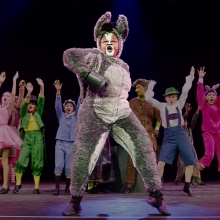The Role of the Artist in SUNDAY IN THE PARK WITH GEORGE
The Role of the Artist in SUNDAY IN THE PARK WITH GEORGE
By Kathryn Harris on March 15, 2010
in
Show/Author Spotlight
| Tags:
lapine, sondheim, Show Spotlight
This is the eighth in a series looking at the work of Stephen Sondheim.
 "Putting it together," states the James Lapine/Stephen Sondheim musical, SUNDAY IN THE PARK WITH GEORGE, "that's what counts." And it does, for 19th century neo-impressionist painter George Seurat and his great-grandson George-although through very different ways, due to their positions in society. Seurat's art keeps him on the outside of mainstream society and the artistic community, whereas George has to be engaged in both.
"Putting it together," states the James Lapine/Stephen Sondheim musical, SUNDAY IN THE PARK WITH GEORGE, "that's what counts." And it does, for 19th century neo-impressionist painter George Seurat and his great-grandson George-although through very different ways, due to their positions in society. Seurat's art keeps him on the outside of mainstream society and the artistic community, whereas George has to be engaged in both.
Artists Are So--
The first act of SUNDAY IN THE PARK WITH GEORGE looks at the role of the artist in 1884 France. Seurat has firmly established himself as being apart from society; he rarely speaks to anyone other than his lover and model, Dot. As Seurat sketches the people relaxing on an island in the Seine, it becomes apparent to his subjects that Seurat is even outside their class system. He has enough money to devote all his time to painting instead of a job with a reliable income, yet a boatman sees him as an ally. "Sunday hypocrites, that's what they are," the boatman declares to Seurat, referring to the people around them. "Muttering and murmuring about this one and that one. I'll take my old dog for company any day." Because Seurat does not engage with those in higher social classes, the boatman feels those people see them as "loonies," explaining that he and Seurat "tell them the truth." At the same time, the boatman considers artists to be "high and mighty," and becomes defensive when he notices Seurat sketching him:
"Who the hell you think you're drawing?
Me?
You don't know me.
Go on drawing.
Since you're drawing only what you want to see,
Anyway...
Draw your own conclusion,
All you artists do.
I see what is true."
Once the boatman realizes that the honesty in Seurat's art isn't limited to wealthy members of society, he stops seeing Seurat as a compatriot, seeing him instead as an observer operating independent of class-and, consequently, as a threat.
The other people enjoying their Sunday on the island also have difficultly cleanly classifying Seurat. It's clear, however, that he's not like everyone else. "They say that George has another woman," a girl gossips.
"They say that George only lives with tramps...
They say he prowls through the streets
In his top hat after midnight...
And stands there staring up at the lamps...
Artists are so crazy..."
The Only Way To See
Seurat is further differentiated because of what he does for a living. Unlike most people in his community, Seurat does not find motivation in making money, and his profession is widely understood to be unprofitable. Although Dot is still in love with Seurat, she leaves him for Louis the baker in part for that very reason. "Louis' art is not hard to swallow," so "Louis sells what he makes." Dot's decision doesn't surprise Seurat's own mother, who notes that "You cannot eat paintings...not when there's bread in the oven." Moreover, it's unclear if Seurat's art qualifies as work. One servant argues that "Artists work...I believe they work very hard;" her husband insists that isn't the case.
"We work...
While he "creates"
We scrape their plates
And dust their knickknacks,
Hundreds to a shelf.
Work is what you do for others...
Art is what you do for yourself."
It'd be one thing if Seurat were simply one of a separate class of artists. But due to his experimental technique, he doesn't even have a place there. Jules, a more successful painter, regularly expresses concern for Seurat. "Your life needs spice, George," Jules urges. "Go to some parties. That is where you'll meet prospective buyers. Have some fun." Jules worries that Seurat's consuming devotion to his work-at the expense of human connection-has caused his art to suffer. Seurat's unwillingness to "paint like [Jules] or anybody else" only fuels Jules' fears. When Seurat reveals that he is "using a different brushstroke," Jules explodes. "Always changing! Why keep changing?" Later, when Seurat tries to explain how he's incorporated scientific principles into his work, Jules becomes more frustrated. "You are a painter, not a scientist!" he insists. "I have touted your work in the past, and now you are embarrassing me!" Seurat's innovations, stemming from his desire to "get through to something new," alienate him from an artistic community resistant to change. Seurat's art therefore keeps him on the outskirts of even a marginalized community.
Art Isn't Easy
The second act of SUNDAY IN THE PARK WITH GEORGE takes the audience to a museum presentation-and the cocktail party that follows-in 1984. The importance of collaboration amongst artists and people from a variety of fields is evident from the beginning of George's presentation. George creates machines that work with light, color, and sound that he calls Chromolumes, and considers himself an inventor as well as a sculptor. When the presentation suddenly stops, George's technician and his composer rush to identify and fix the problem. Because his art is so reliant on technology, George can't do his work unless he enlists the assistance and expertise of people who aren't visual artists.
George also needs to work with non-artists for funding and support. His latest Chromolume presentation isn't only to present his artistic vision to the public; he also hopes it will impress museum board members, foundation heads, and critics. George is well aware that the post-presentation cocktail party is just as important as the presentation itself. "Link by link, making the connections," he describes as he goes from group to group, always with a drink in hand.
"Adding just a dab of politician
(Always knowing where to draw the line).
Lining up the funds but in addition
Lining up a prominent commission,
Otherwise your perfect composition
Isn't going to get much exhibition."
The most Seurat does by way of self-promotion is ask Jules to get his work in the upcoming exhibition. Not so this George, who schmoozes his way through an entire musical number ("Putting It Together"). Money is very much on everyone's mind: when the museum's head of public relations tells George he "made quite a stir tonight," George's composer quickly jumps in. "You see, George-that electrical screw-up didn't hurt our reception," she assures him.
While Seurat dislikes other painters, George seems to be very much a part of the artistic community. He talks to other artists just as easily as he speaks to anyone else, and he accepts their opinions on his work without getting arrogant or defensive. There are a set number of commissions and a set amount of funding, but instead of viewing other artists as competitors, George recognizes that he needs artist friends to survive in such an unstable environment. "Overnight, you're a trend, you're the right combination," he explains.
"Then the trend's at an end,
You're suddenly last year's sensation...
So you should support the competition,
Try to set aside your own ambition,
Even while you jockey for position-
If you feel a sense of coalition,
Then you never really stand alone."
The way to stay relevant for George and his fellow artists is not to stick to traditional methods and current trends, but to subvert them. "You can't divide art today into categories neatly," an arts patron remarks. The museum director elaborates:
"It's not enough telling good from rotten
When something new pops up every day.
It's only new, though, for now-
But yesterday's forgotten."
20th century artists such as George depend on networking to even be artists in the first place.
Move On
SUNDAY IN THE PARK WITH GEORGE traces the role of the artist in society from 19th century eccentric to 20th century politician/entrepreneur. Seurat's overwhelming focus on his work causes him to avoid the parties where he would network, but because of the marginalized nature of artists at the time, he doesn't need to. George, however, is an artist in an age where collaborating is critical; skipping social events isn't an option. Seurat may have been content working by himself, but his innovations weren't acknowledged until after his death. George certainly possesses the social skills to secure commissions and grants, but he's criticized for building Chromolume after Chromolume instead of pushing himself creatively. With the help of his grandmother Dot, George eventually learns how to concentrate as Seurat does, becoming a more balanced artist in the process.

For more information and to license SUNDAY IN THE PARK WITH GEORGE, check out our MTI show page. To share your thoughts on this article or discuss the show, visit SUNDAY IN THE PARK WITH GEORGE's MTI ShowSpace page.
 "Putting it together," states the James Lapine/Stephen Sondheim musical, SUNDAY IN THE PARK WITH GEORGE, "that's what counts." And it does, for 19th century neo-impressionist painter George Seurat and his great-grandson George-although through very different ways, due to their positions in society. Seurat's art keeps him on the outside of mainstream society and the artistic community, whereas George has to be engaged in both.
"Putting it together," states the James Lapine/Stephen Sondheim musical, SUNDAY IN THE PARK WITH GEORGE, "that's what counts." And it does, for 19th century neo-impressionist painter George Seurat and his great-grandson George-although through very different ways, due to their positions in society. Seurat's art keeps him on the outside of mainstream society and the artistic community, whereas George has to be engaged in both.Artists Are So--
The first act of SUNDAY IN THE PARK WITH GEORGE looks at the role of the artist in 1884 France. Seurat has firmly established himself as being apart from society; he rarely speaks to anyone other than his lover and model, Dot. As Seurat sketches the people relaxing on an island in the Seine, it becomes apparent to his subjects that Seurat is even outside their class system. He has enough money to devote all his time to painting instead of a job with a reliable income, yet a boatman sees him as an ally. "Sunday hypocrites, that's what they are," the boatman declares to Seurat, referring to the people around them. "Muttering and murmuring about this one and that one. I'll take my old dog for company any day." Because Seurat does not engage with those in higher social classes, the boatman feels those people see them as "loonies," explaining that he and Seurat "tell them the truth." At the same time, the boatman considers artists to be "high and mighty," and becomes defensive when he notices Seurat sketching him:
"Who the hell you think you're drawing?
Me?
You don't know me.
Go on drawing.
Since you're drawing only what you want to see,
Anyway...
Draw your own conclusion,
All you artists do.
I see what is true."
Once the boatman realizes that the honesty in Seurat's art isn't limited to wealthy members of society, he stops seeing Seurat as a compatriot, seeing him instead as an observer operating independent of class-and, consequently, as a threat.
The other people enjoying their Sunday on the island also have difficultly cleanly classifying Seurat. It's clear, however, that he's not like everyone else. "They say that George has another woman," a girl gossips.
"They say that George only lives with tramps...
They say he prowls through the streets
In his top hat after midnight...
And stands there staring up at the lamps...
Artists are so crazy..."
The Only Way To See
Seurat is further differentiated because of what he does for a living. Unlike most people in his community, Seurat does not find motivation in making money, and his profession is widely understood to be unprofitable. Although Dot is still in love with Seurat, she leaves him for Louis the baker in part for that very reason. "Louis' art is not hard to swallow," so "Louis sells what he makes." Dot's decision doesn't surprise Seurat's own mother, who notes that "You cannot eat paintings...not when there's bread in the oven." Moreover, it's unclear if Seurat's art qualifies as work. One servant argues that "Artists work...I believe they work very hard;" her husband insists that isn't the case.
"We work...
While he "creates"
We scrape their plates
And dust their knickknacks,
Hundreds to a shelf.
Work is what you do for others...
Art is what you do for yourself."
It'd be one thing if Seurat were simply one of a separate class of artists. But due to his experimental technique, he doesn't even have a place there. Jules, a more successful painter, regularly expresses concern for Seurat. "Your life needs spice, George," Jules urges. "Go to some parties. That is where you'll meet prospective buyers. Have some fun." Jules worries that Seurat's consuming devotion to his work-at the expense of human connection-has caused his art to suffer. Seurat's unwillingness to "paint like [Jules] or anybody else" only fuels Jules' fears. When Seurat reveals that he is "using a different brushstroke," Jules explodes. "Always changing! Why keep changing?" Later, when Seurat tries to explain how he's incorporated scientific principles into his work, Jules becomes more frustrated. "You are a painter, not a scientist!" he insists. "I have touted your work in the past, and now you are embarrassing me!" Seurat's innovations, stemming from his desire to "get through to something new," alienate him from an artistic community resistant to change. Seurat's art therefore keeps him on the outskirts of even a marginalized community.
Art Isn't Easy
The second act of SUNDAY IN THE PARK WITH GEORGE takes the audience to a museum presentation-and the cocktail party that follows-in 1984. The importance of collaboration amongst artists and people from a variety of fields is evident from the beginning of George's presentation. George creates machines that work with light, color, and sound that he calls Chromolumes, and considers himself an inventor as well as a sculptor. When the presentation suddenly stops, George's technician and his composer rush to identify and fix the problem. Because his art is so reliant on technology, George can't do his work unless he enlists the assistance and expertise of people who aren't visual artists.
George also needs to work with non-artists for funding and support. His latest Chromolume presentation isn't only to present his artistic vision to the public; he also hopes it will impress museum board members, foundation heads, and critics. George is well aware that the post-presentation cocktail party is just as important as the presentation itself. "Link by link, making the connections," he describes as he goes from group to group, always with a drink in hand.
"Adding just a dab of politician
(Always knowing where to draw the line).
Lining up the funds but in addition
Lining up a prominent commission,
Otherwise your perfect composition
Isn't going to get much exhibition."
The most Seurat does by way of self-promotion is ask Jules to get his work in the upcoming exhibition. Not so this George, who schmoozes his way through an entire musical number ("Putting It Together"). Money is very much on everyone's mind: when the museum's head of public relations tells George he "made quite a stir tonight," George's composer quickly jumps in. "You see, George-that electrical screw-up didn't hurt our reception," she assures him.
While Seurat dislikes other painters, George seems to be very much a part of the artistic community. He talks to other artists just as easily as he speaks to anyone else, and he accepts their opinions on his work without getting arrogant or defensive. There are a set number of commissions and a set amount of funding, but instead of viewing other artists as competitors, George recognizes that he needs artist friends to survive in such an unstable environment. "Overnight, you're a trend, you're the right combination," he explains.
"Then the trend's at an end,
You're suddenly last year's sensation...
So you should support the competition,
Try to set aside your own ambition,
Even while you jockey for position-
If you feel a sense of coalition,
Then you never really stand alone."
The way to stay relevant for George and his fellow artists is not to stick to traditional methods and current trends, but to subvert them. "You can't divide art today into categories neatly," an arts patron remarks. The museum director elaborates:
"It's not enough telling good from rotten
When something new pops up every day.
It's only new, though, for now-
But yesterday's forgotten."
20th century artists such as George depend on networking to even be artists in the first place.
Move On
SUNDAY IN THE PARK WITH GEORGE traces the role of the artist in society from 19th century eccentric to 20th century politician/entrepreneur. Seurat's overwhelming focus on his work causes him to avoid the parties where he would network, but because of the marginalized nature of artists at the time, he doesn't need to. George, however, is an artist in an age where collaborating is critical; skipping social events isn't an option. Seurat may have been content working by himself, but his innovations weren't acknowledged until after his death. George certainly possesses the social skills to secure commissions and grants, but he's criticized for building Chromolume after Chromolume instead of pushing himself creatively. With the help of his grandmother Dot, George eventually learns how to concentrate as Seurat does, becoming a more balanced artist in the process.
Original Broadway Cast
For more information and to license SUNDAY IN THE PARK WITH GEORGE, check out our MTI show page. To share your thoughts on this article or discuss the show, visit SUNDAY IN THE PARK WITH GEORGE's MTI ShowSpace page.

























